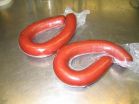(Press-News.org) By hightailing it to nearby ponds and shallow waterways, frogs and salamanders have – until now – had a way to evade exotic trout introduced to the West's high-mountain lakes for recreational fishing.
A warming climate, however, will dry up some of the places where amphibians and their young have found refuge. Researchers in the May 1 issue of Frontiers in Ecology and the Environment write about this challenge and a novel combination of tools that could help land managers, biologists, fishing enthusiasts and other citizens weigh where amphibians are in the most need of help and guide plans for possible fish removals from selected lakes.
"Amphibians in the West's high-mountain areas find themselves in a vice, caught between climate-induced habitat loss and predation from introduced fish," said Maureen Ryan, a University of Washington postdoctoral researcher in environmental and forest sciences, a Simon Fraser University research associate and lead author of the paper.
Among the tools that could prove useful is a hydrologic model, currently used to project river flows, that can be applied to wetlands as a way to evaluate the effects of projected climate change. New remote-sensing techniques, using what's called object-based image analysis, allow managers to use existing aerial and satellite imagery to map wetlands in remote and previously un-surveyed regions.
Along with biological survey data these tools "can be used to identify regions where native wetland animals are most at risk of the combined effects of climate change and fish. In these regions, fish removal from strategic sites can be used to restore resilience to a landscape where inaction might lead to tipping points of species loss," writes Ryan and her co-authors Wendy Palen of Simon Fraser University, Michael Adams of the U.S. Geological Survey and Regina Rochefort of the North Cascades National Park.
The work was funded by the Department of the Interior's Northwest Climate Science Center, the David H. Smith Conservation Research Fellowship Program and the U.S. Fish and Wildlife Service's Pacific Northwest Landscape Conservation Cooperative.
In some parts of the West, programs of fish removal are already in place. Jack Oelfke, a manager at North Cascades National Park in Washington state says he watched long-toed salamanders, northwestern salamanders and tailed frogs return to lakes that his crews cleared of introduced trout. Fish stocking was halted in the park in 2007 after the park and Washington state completed an extensive environmental impact statement. The park began trout removal at eight lakes in 2009.
When considering removing fish, Ryan said human uses such as fishing are a part of the discussion. For the North Cascades National Park, for example, several high-lakes fisheries groups were involved.
"People often ask me what we can do about amphibian declines," said co-author Adams. "Fish removal is something that we know will help, but is hard to do and not always popular, so we need to be smart about it. This project provides a tool that can help target fish removal to places where it will do the most good for amphibians."
In some places, if a lake is no longer artificially stocked with fish, the trout will naturally disappear. Non-native fish also can be removed using a variety of techniques including gill nets or piscicides like the organic compound rotenone, which is extracted from plants.
As glaciers receded at the end of the last ice age they left behind thousands of isolated high mountain lakes and ponds devoid of fish. The bodies of water range in size from many acres, large enough to sail a boat on is how Ryan describes them, to ones smaller than your living room.
For centuries frogs, salamanders and other aquatic species flourished in these high elevation habitats where food was plentiful and their eggs and young were relatively safe from predators. In the late 1800s things started to change when trout were brought to mountain lakes and ponds in the American West by settlers looking for recreational fishing opportunities. Stocking intensified after World War II with millions of fish being dropped from aircraft by agency wildlife managers. Today 95 percent of the large mountain lakes have trout.
At risk are species such as the Cascades frog. Found only at high elevations in Washington, Oregon and California, Cascades frogs can live for 20 or more years, can survive under 30 feet of snow and, during the mating season, the males make chuckling sounds.
"We hope newly developed wetland modeling tools can improve climate adaptation action plans so ecosystems can maintain their resilience in the face of a changing climate," Ryan said.
INFORMATION:
For more information:
Ryan, 360-685-3640, moryan@uw.edu
Adams, 541-750-0980, mjadams@usgs.gov
Palen, 778-997-4129, wpalen@sfu.ca
Suggested websites
--Frontiers in Ecology and the Environment
http://www.frontiersinecology.org/front/
Amphibians in a vice: Climate change robs frogs, salamanders of refuge
2014-05-01
ELSE PRESS RELEASES FROM THIS DATE:
New discovery: Molecule links asthma and cancer and could aid in developing new treatments
2014-05-01
A newly discovered molecule provides a new drug target for controlling both asthma-induced muscle thickening and cancerous tumor growth. This molecule, called "microRNA-10a," normally helps genes produce proteins or make copies of themselves, also play an important role in the growth or overgrowth of human airway smooth muscle cells and some forms of cancer. This newly discovered role, which was published in the May 2014 issue of The FASEB Journal, suggests that manipulating microRNA-10a could lead to new asthma and cancer drugs.
"We hope this study will serve as the ...
Killing Kindlin-3 to cure breast cancer: 'Blood' protein implicated
2014-05-01
A protein believed to be limited to the hematopoietic system, called Kindlin-3, has been identified as a major player in both the formation and spread of breast cancer to other organs. This discovery, published in the May 2014 issue of The FASEB Journal, could open the door to an entirely new class of breast cancer drugs that targets this protein's newly found activity.
"Kill Kindlin-3 to cure cancer," said Elzbieta Pluskota, Ph.D., a researcher involved in the work from the Department of Molecular Cardiology at the Cleveland Clinic Lerner Research Institute in Cleveland, ...
Monitoring, management, and oversight critical for responsible shale gas development
2014-05-01
Ottawa (May 1st, 2014) – A new expert panel report, Environmental Impacts of Shale Gas Extraction in Canada, concludes that shale gas development must be supported by well-targeted science and management strategies to understand and mitigate potential impacts. The report, released today by the Council of Canadian Academies, addresses environmental and associated health impacts and offers insights regarding public engagement and trust.
Shale gas is leading an energy boom which is having profound economic, environmental, and social impacts across much of North America. ...
Rules of thumb: 3 simple ideas for overcoming childhood obesity
2014-05-01
New Orleans, LA – Kristopher Kaliebe, MD, Clinical Assistant Professor of Psychiatry at the LSU Health Sciences Center New Orleans School of Medicine, offers parents and caregivers three simple family-oriented goals to overcome the complex problem of childhood obesity and related mental disorders. They involve limit setting to address the brain's "get more" drive strengthened through habitual over-consumption of temptations including highly caloric processed food, hyper-reality media and electronics, as well as excessive sitting. His 3 "rules" of living promote physical ...
Individual brain activity predicts tendency to succumb to daily temptations
2014-05-01
Activity in areas of the brain related to reward and self-control may offer neural markers that predict whether people are likely to resist or give in to temptations, like food, in daily life, according to research in Psychological Science, a journal of the Association for Psychological Science.
"Most people have difficulty resisting temptation at least occasionally, even if what tempts them differs," say psychological scientists Rich Lopez and Todd Heatherton of Dartmouth College, authors on the study. "The overarching motivation of our work is to understand why some ...
Antimicrobial edible films inhibit pathogens in meat
2014-05-01
Antimicrobial agents incorporated into edible films applied to foods to seal in flavor, freshness and color can improve the microbiological safety of meats, according to researchers in Penn State's College of Agricultural Sciences.
Using films made of pullulan -- an edible, mostly tasteless, transparent polymer produced by the fungus Aureobasidium pulluns -- researchers evaluated the effectiveness of films containing essential oils derived from rosemary, oregano and nanoparticles against foodborne pathogens associated with meat and poultry.
The results demonstrate that ...
Researchers find the accelerator for molecular machines
2014-05-01
How hard can it be to make a wheel rotate in a machine? Very hard actually, when the wheel sits in one of those nano-small molecular machines that are predicted to be running our future machines. But before the molecular machines become part of our daily lives, researchers must be able to control them. A Danish/American research team have now solved part of this problem.
There are large machines and there are small machines - and then there are molecular machines. They are nano-tiny collections of molecular building blocks that together make up a machine and operate various ...
Unlocking a mystery of thalidomide
2014-05-01
In the 1950s and 1960s, pregnant women with morning sickness were often prescribed the new drug thalidomide. Shortly after the medicine was released on the market, a reported 10,000 infants were born with an extreme form of the rare congenital phocomelia syndrome, which caused death in 50 percent of cases and severe physical and mental disabilities in others. Although various factors are now known to cause phocomelia, the prominent roots of the disease can be found in the use of the drug thalidomide.
Now, half a century later, new research by Dr. Noam Shomron, Prof ...
New study suggests combination of statin and omega-3 fatty acid may provide cardioprotective effects
2014-05-01
Boston, MA-- New findings from an in vitro study, led by researchers at Brigham and Women's Hospital (BWH), show that the combination of statins and eicosapentaenoic acid (EPA), an omega-3 fatty acid, may potentially reduce cardiovascular risk. This research is being presented May 1 at a peer-reviewed poster session at the National Lipid Association Scientific Sessions in Orlando, Florida.
"We know that endothelial cell dysfunction is emerging as an early and important predictor of cardiovascular disease and plays an essential role in plaque development. Treatments that ...
Risk of weight gain deters some smokers from seeking treatment to quit
2014-05-01
Smokers may avoid treatment to quit smoking if they previously gained weight while trying to quit, according to researchers at Penn State College of Medicine.
Weight gain is a predictable occurrence for smokers who have recently quit. Within the first year after quitting, they gain an average of eight to14 pounds, and some smokers report that they keep smoking simply because they do not want to gain weight from quitting.
Susan Veldheer, project manager in the Department of Public Health Sciences, predicted that smokers would avoid treatment to quit if they are highly ...


